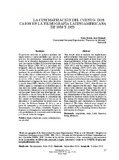La cinematización del cuento: dos casos en la fi lmografía Latinoamericana de 1939 y 1953

View/
Date
2019Author
Palabras Clave
Adaptación, Cuento, Latinoamérica, Ser, OtredadAdaptation, Story, Latin America, Being, Otherness
Metadata
Show full item recordAbstract
El presente artículo se plantea analizar las implicaciones y particularidades que suscita la
práctica de equivalentes cinematográficos de textos de la literatura latinoamericana, en este
caso, los cuentos del libro El Diosero del mexicano Francisco Rojas (1904-1951) y los relatos del
uruguayo Horacio Quiroga (1878-1937) han servido de punto de partida para el desarrollo,
mediante las posibilidades del arte fílmico, de dos producciones audiovisuales en diferentes
momentos del cine regional (Prisioneros de la tierra, 1939 y Raíces, 1953). El análisis se
fundamentará en algunas nociones sobre literatura y cine de Stam (2009), Sánchez (2001) y Martínez
(2004), quien se concentra en el abordaje que el cine hace del cuento. Algunos trabajos sobre los
textos fuentes (literarios) y las películas también servirán para desarrollar esta investigación. Así,
encubiertos o no, en busca de su reivindicación, los otros se levantan mediante la cinematización
del cuento en Latinoamérica y buscan en la literatura y su posibilidad de proyectarse en
el cine, las diversas formas de decir y ser a partir de momentos y circunstancias históricas
determinadas. Los filmes estudiados llegaron a fraguarse en el imaginario cinematográfico gracias
a las posibilidades de la relación entre la literatura y el cine de todos los tiempos.
Collections
Información Adicional
| Otros Títulos | The cinematization of the story: two cases in the latin american fi lmography of 1939 and 1953 |
| Correo Electrónico | manueljnm@hotmail.com |
| Editor | SaberULA |
| ISSN | 0798-1570 |
| ISSN Electrónico | 2244-8438 |
| Resumen en otro Idioma | This article aims to analyze the implications and peculiarities that arise from the practice of cinematographic equivalents of texts from Latin American literature, in this case, the stories of the book El Diosero by the Mexican Francisco Rojas (1904-1951) and the stories of the Uruguayan Horacio Quiroga (1878-1937) have served as a starting point for the development, through the possibilities of film art, of two audiovisual productions at different times in regional cinema (Prisioneros de la tierra, 1939 and Raíces, 1953). The analysis will be based on some notions about literature and cinema by Stam (2009), Sánchez (2001) and Martínez (2004), who focuses on the film’s approach to the story. Some works on source texts (literary) and films will also serve to develop this research. Thus, hidden or not, in search of their claim, the others are raised through the cinematization of the story in Latin America and look at literature and its ability to project in the cinema, the various ways of saying and being from moments and circumstances determined historical The films studied were forged in the cinematographic imaginary thanks to the possibilities of the relationship between literature and cinema of all times. |
| Colación | 37-50 |
| Periodicidad | Semestral |
| País | Venezuela |
| Institución | Universidad de Los Andes |
| Sección | Cifra Nueva: Artículos |





